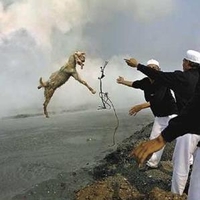The Goat that Couldn’t Stop the Mud Volcano
Sacrifice, Subjectivity, and Indonesia’s “Lapindo Mudflow”
DOI:
https://doi.org/10.52537/humanimalia.10033Abstract
This essay explores the relationship between animal sacrifice, the production of human subjectivity, and expressions of power, using a newspaper photograph of a goat being thrown into a famous mud volcano in Indonesia as a point of departure. This devastating mud volcano, widely known as the “Lapindo” mudflow, began in 2006 and continues to release mud in 2012. I also use this disaster as a case study to observe the ways violence against nonhumans helps sustain individuals and communities within certain social and ecological orders, both in Western and Indonesian contexts. As this project traces the various ways sacrificial violence expresses subjectivity, it will consider the staging of unequal power relations in both the execution and the representation of the sacrifice ritual. By recognizing these manifestations of power, we – who have the cognitive faculties, cultural determinations, and social agencies that enable us to perform violence, abstain from performing violence, and contemplate occurrences of violence – refine our capacity to not only identify violence toward other animals, including other members of our own species, but also understand the ways violence shapes our being and relating within ecological networks, so that we can become better, or at least more self-aware, actors in our ecological communities. (PD)
Downloads

Downloads
Published
Issue
Section
License

This work is licensed under a Creative Commons Attribution-NonCommercial 4.0 International License.


